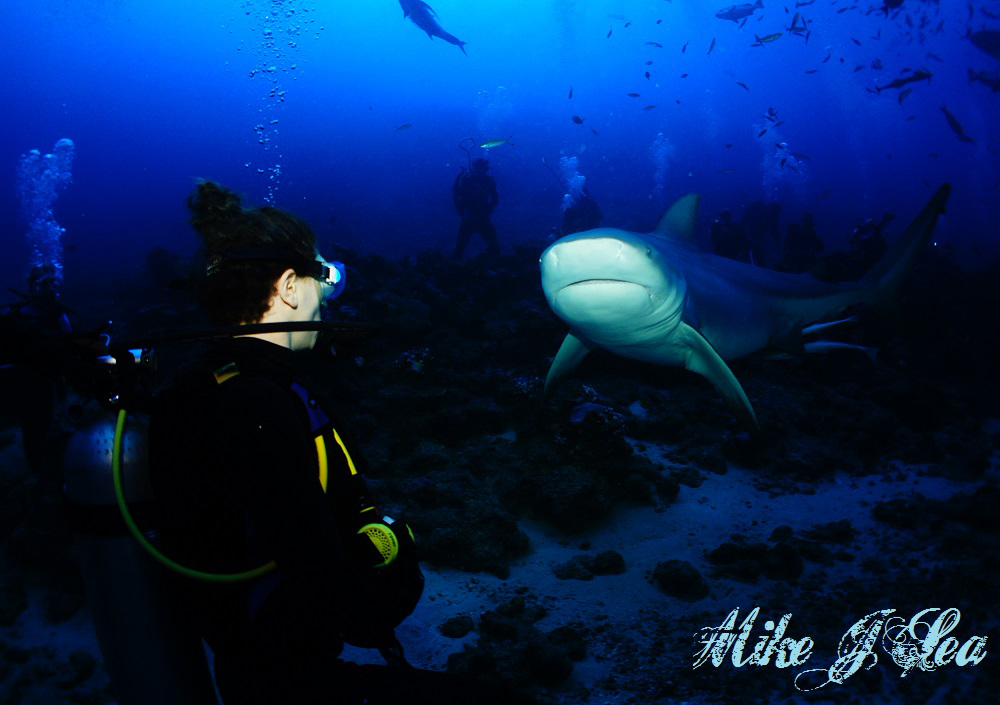I’m in Fiji on a research expedition with Joshua Drew from Columbia University. Before the hard research work started I took off a day and went diving with bull sharks. Read part 1 of my encounter with some of the oceans biggest predators here.
Within a minute or two of being surrounded by forty bull sharks I realised I had nothing to worry about. I watched them and watched me. And it soon became obvious that I was of very little interest to them. I had no fish to offer. I was just weird and noisy.
The divemasters from Beqa Adventure Divers treat the sharks with a huge level of respect. These guys know the sharks individually (even after just two dives I started recognising individual sharks – one with a big round chunk missing from its dorsal fin, another with a bent tail, one with a kinked over dorsal). They’ve seen the same sharks come back for years. They’ve got to know their quirks and habits. One shark has visited the feeding site for 8 years and never once ate a thing. Maybe she’s shy? Maybe she’s way down the shark pecking order? Or maybe she’s just nervous of people?
The whole thing felt very calm, controlled and surprisingly slow. There was no frantic feeding frenzy. The bulls have been trained to feed in a certain way. They only get a tuna head if they approach the feeder from the left and swim off to the right. Some of them behaved like giant puppies sniffing around the food bin, but they wouldn’t get a bite unless they did the right thing.
Scientists have know this for a while: you can train a shark just like you can train a dog.
At one point a tuna head drifted towards me and I recalled a story I’d heard about a diver in Australia getting bit by a shark when a piece of fish came too close. But I calmly kept an eye on the tuna and the shark that slowly approached and chomped it down in one gulp into its impressively huge maw.
Only once did my bodyguard (a divemaster armed with a metal pole) feel he needed to bop one shark on the nose when it came a teeny tiny bit too close for comfort. I flinched as the shark took the blow to the snout and seemed to indignantly swim off thinking “yeah, ok, I know, I know… sorreeeeee”. (Even a hardened scientist/conservationist like me couldn’t help anthropomorphising just a little bit down there).
All too soon I heard a clanging tank that told us old that the bull shark feed was over. In ten short minutes I had grown totally accustomed to diving with so many huge sharks. But already it was time to ascend to the shallows for shark feed number 2: the reefies.
Up in the coral garden, Papa stationed himself in a cloud of black and white striped sergeant major fish that were going nuts. Here we got to see a bunch of much smaller, much sleeker, much cuter sharks. Compared to the bull sharks, white tip reef sharks behave like naughty kittens. Only a couple of feet long, with tubular bodies, forward-pointing snouts, and a stunning white flash across their dorsal fin. Papa was giving them little morsels of fish and frequently batting them aside when they got too cheeky trying to nose their way into his feeding bag. A four-foot blacktip reef shark also showed up for its share.
We hung onto a rope strung across the reef and got churned around in the waves, watching the reef sharks patrolling in and out. Below us the bull sharks had already dispersed, back to what they were doing before we showed up with dinner.
I came up from my dive convinced that feeding these sharks is a good thing. This whole experience is without doubt showing people that sharks are not mindless killing machines. There’s a lot more going on down there than just eating. The sharks are watching, taking turn, doing what they’re told. And while I’m sure there is some affect on the local ecology from injecting so much additional food into the system every day, its not obvious that this is having a major impact on the reef. And certainly nothing compared to the impact rising temperatures and acidity are soon going to have on reefs – right?
It’s becoming a bit of a cliché to say that sharks are worth more alive in the water than dead in a bowl of soup. But the thing about clichés is they are usually true. And in this case, it definitely is. Millions of dollars a year are raised by this dive operation, and each diver in the water donates 20 Fijian dollars to the local fishing villages who in return have agreed not to fish inside the protected area that Mike, Papa and BAD helped to set up. Now there’s a shark corridor along the southern coast of Viti Levu (enforced mostly by BAD divemasters and boatmen who are trained as fish wardens).
Shark ecotourism may not be a one-size-fits-all conservation solution everywhere, but it is obviously working here with these people and these sharks, and I’m sure it can work elsewhere. More than anything, BAD are helping to chip away at the sharks’ image crisis.
And I hope the fact that I came back safely (with my limbs still intact) will help prove to my friends and family and anyone else reading this that shark-infested waters are really not something to be scared of but something we should do all we can to protect.
#CUinFiji

Leave a Reply